Abstract
1. Methods are described for estimating the half-life of angiotensin analogues and renin in the rat, from the time course of the blood pressure changes they evoke. 2. The following half-life values were measured: angiotensin II, 16 +/- 1 sec; angiotensin III, 14 +/- 1 sec; angiotensin II-amide, 15 +/- 1 sec; Sar1-Ala8-angiotensin II, 6.4 +/- 0.6 min; renin, 3.0 +/- 0.4 min. The distribution volume of angiotensin was found to be 18 ml./kg body wt. 3. It is inferred that the Asp1 residue does not reduce the rate of angiotensin II catabolism, but that substitution of this residue by sarcosine may inhibit catabolism while substitution by asparagine has no effect. 4. Five experimental criteria were identified which indicate that these methods give reliable estimates of the half-life. It is suggested that these results are more accurate than most previous half-life estimates. 5 When tachyphylaxis to angiotensin II-amide occurs, the pressor activity of the plasma is not reduced.
Full text
PDF
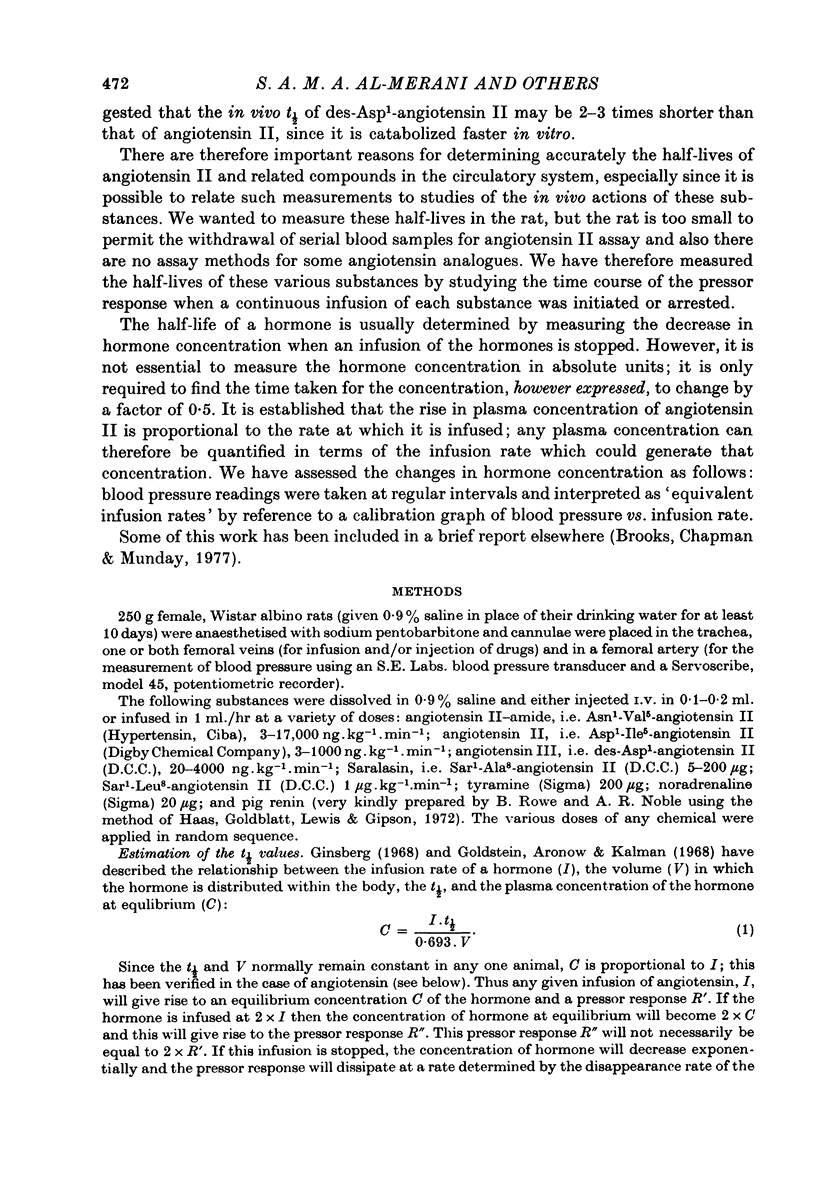
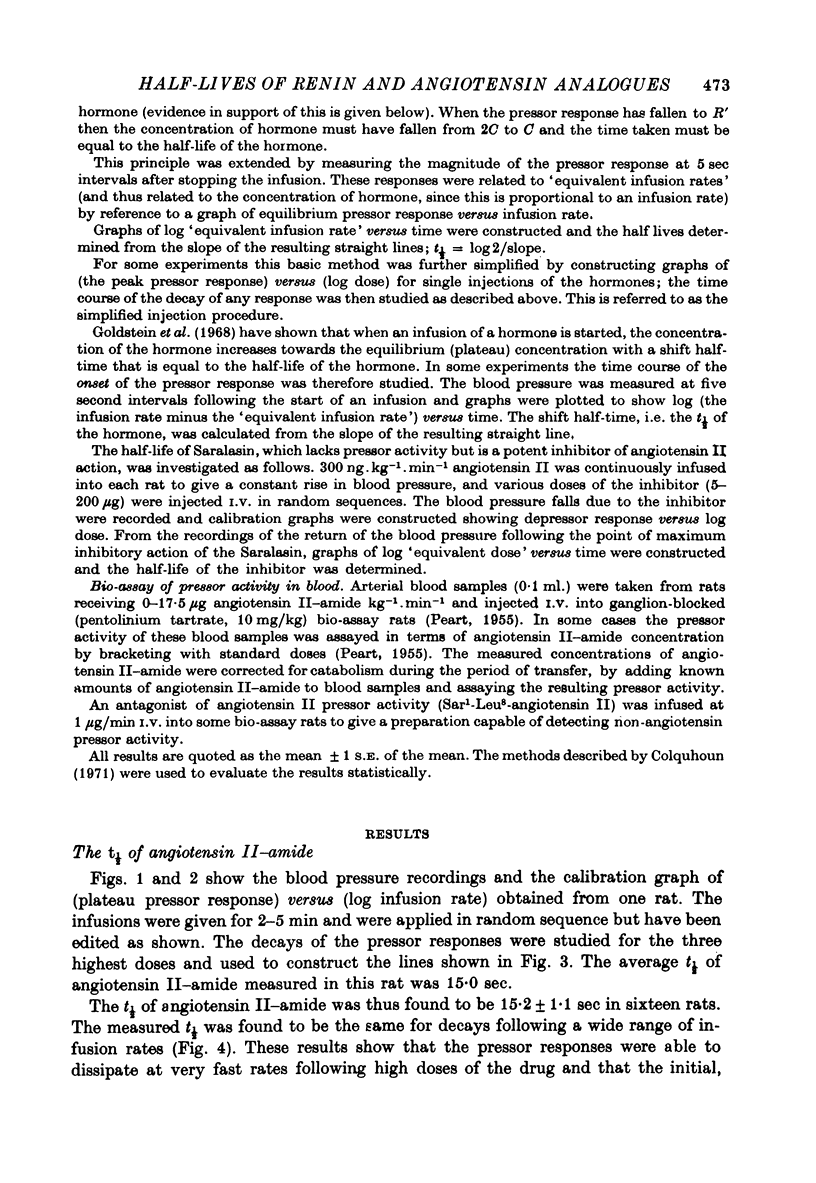
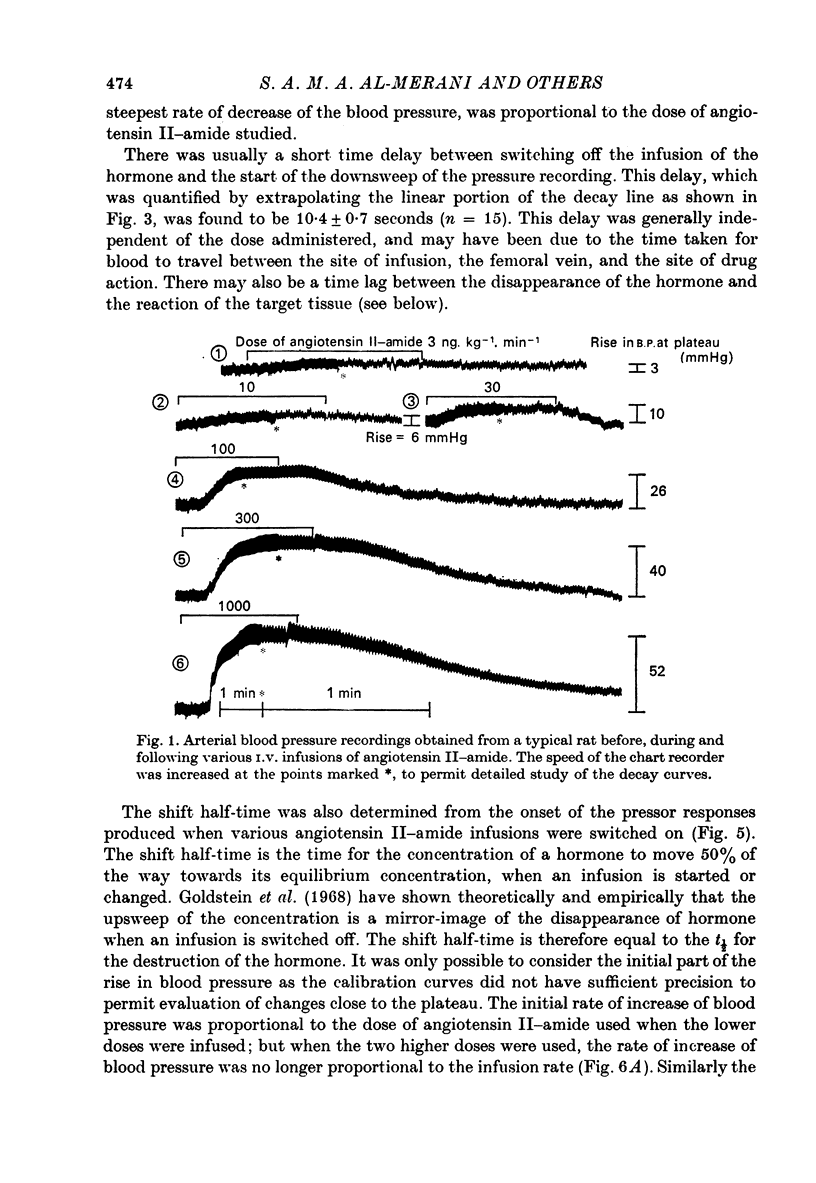
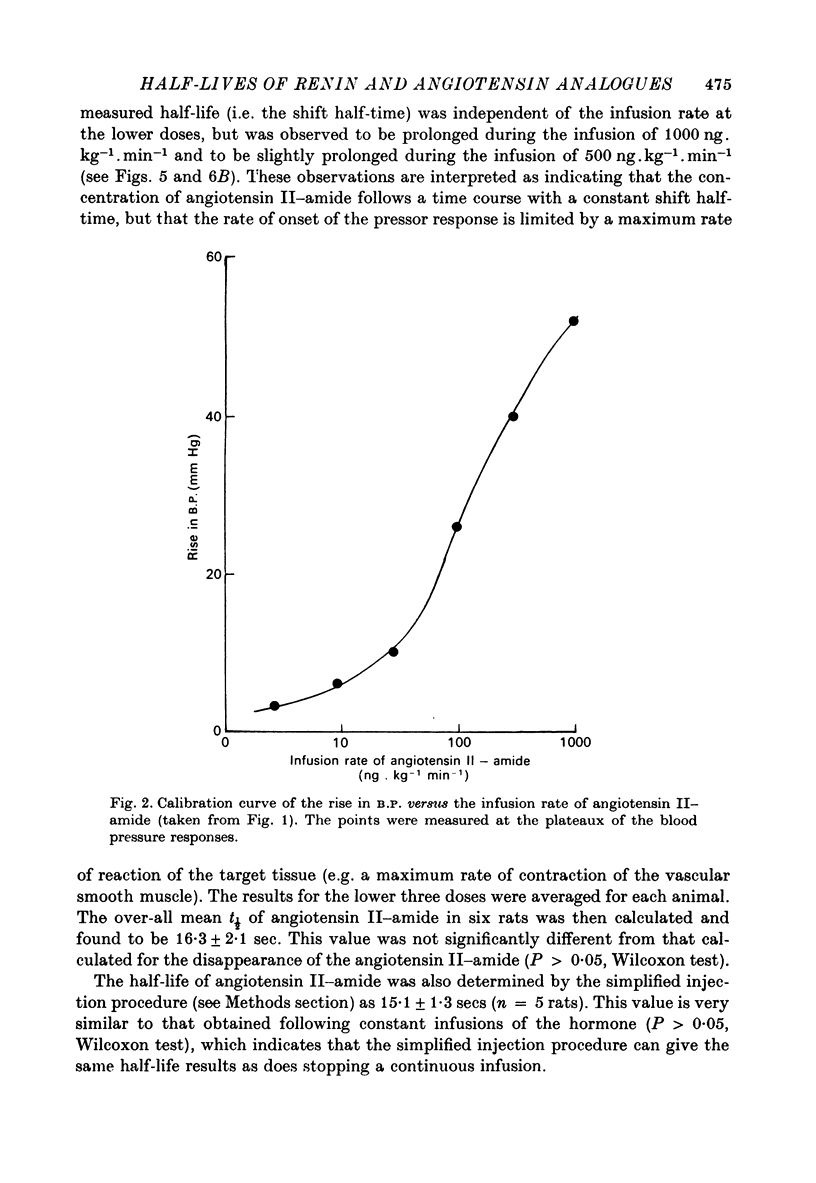
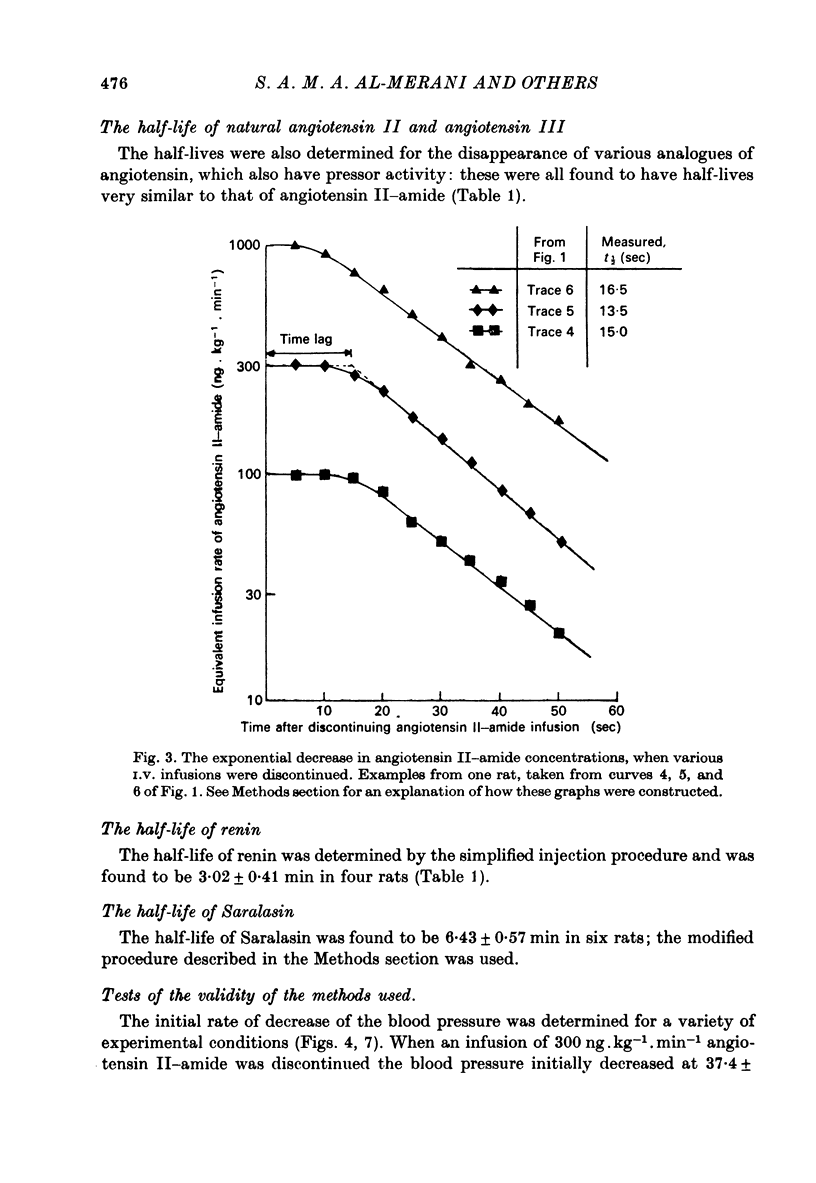
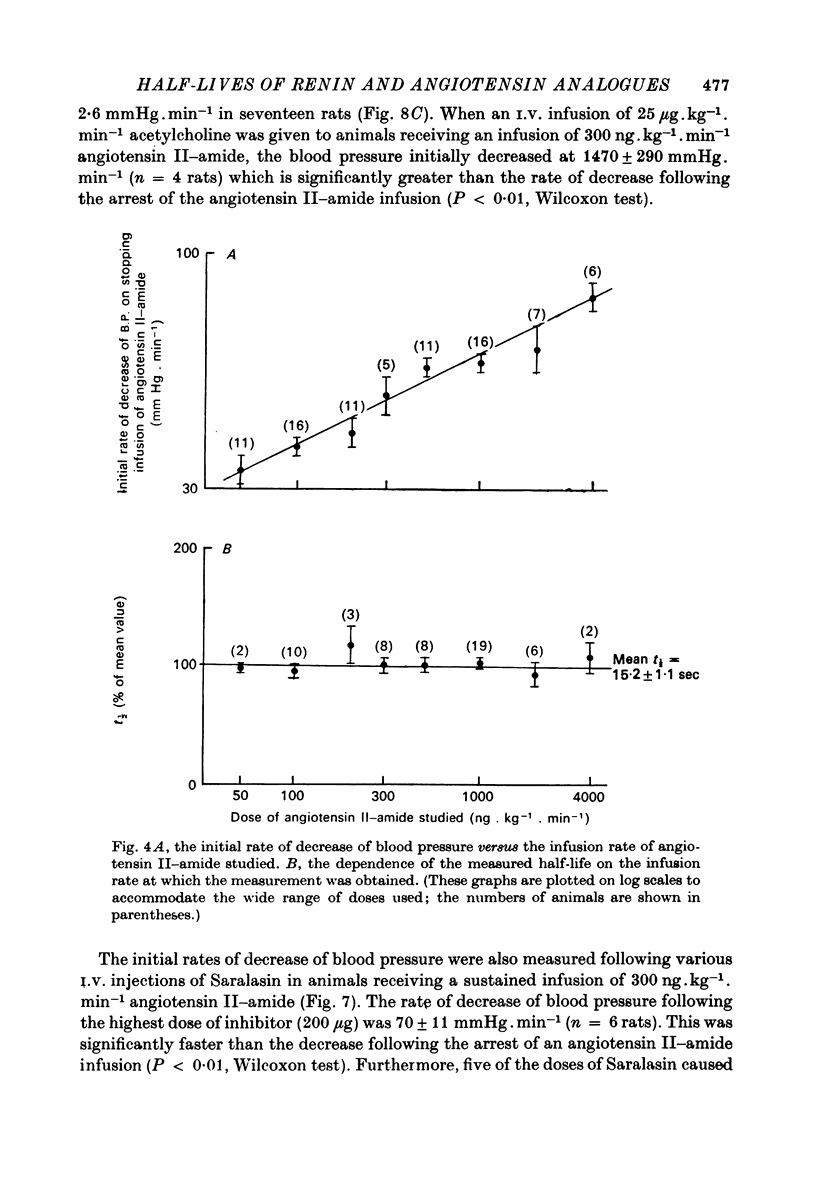
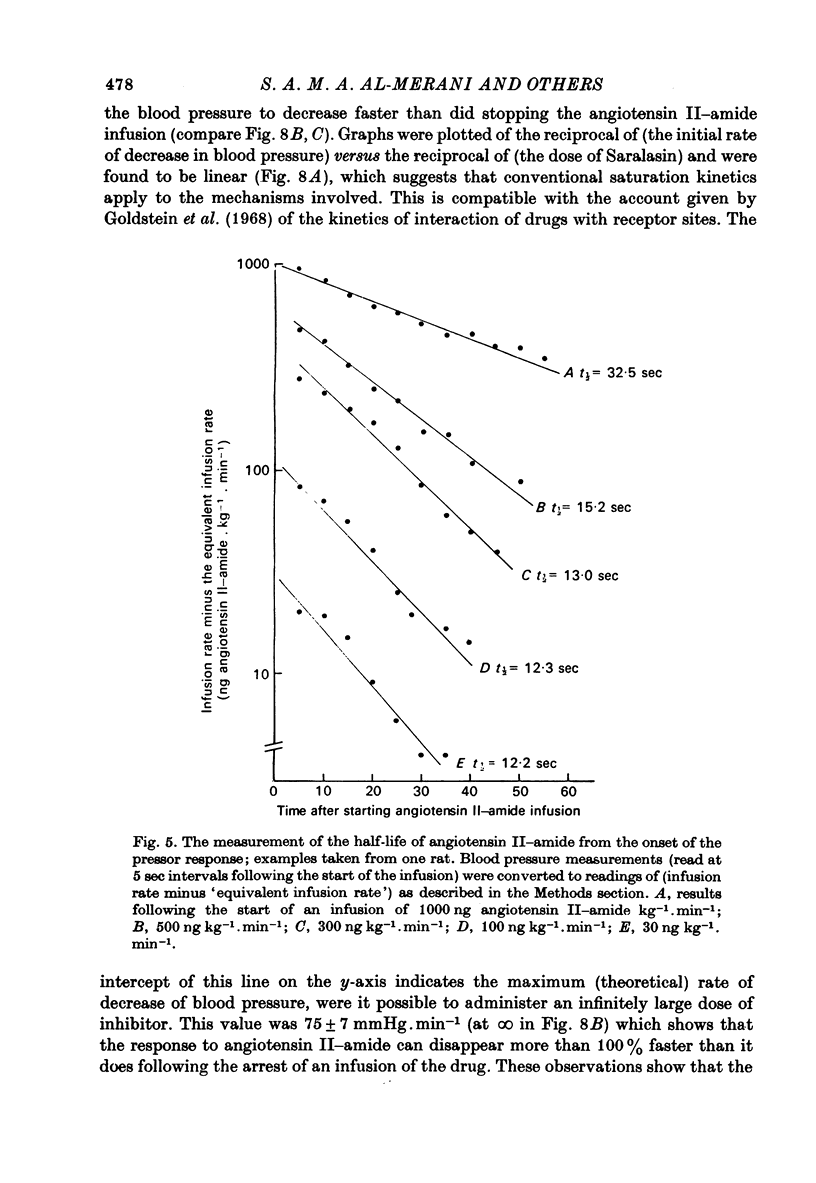
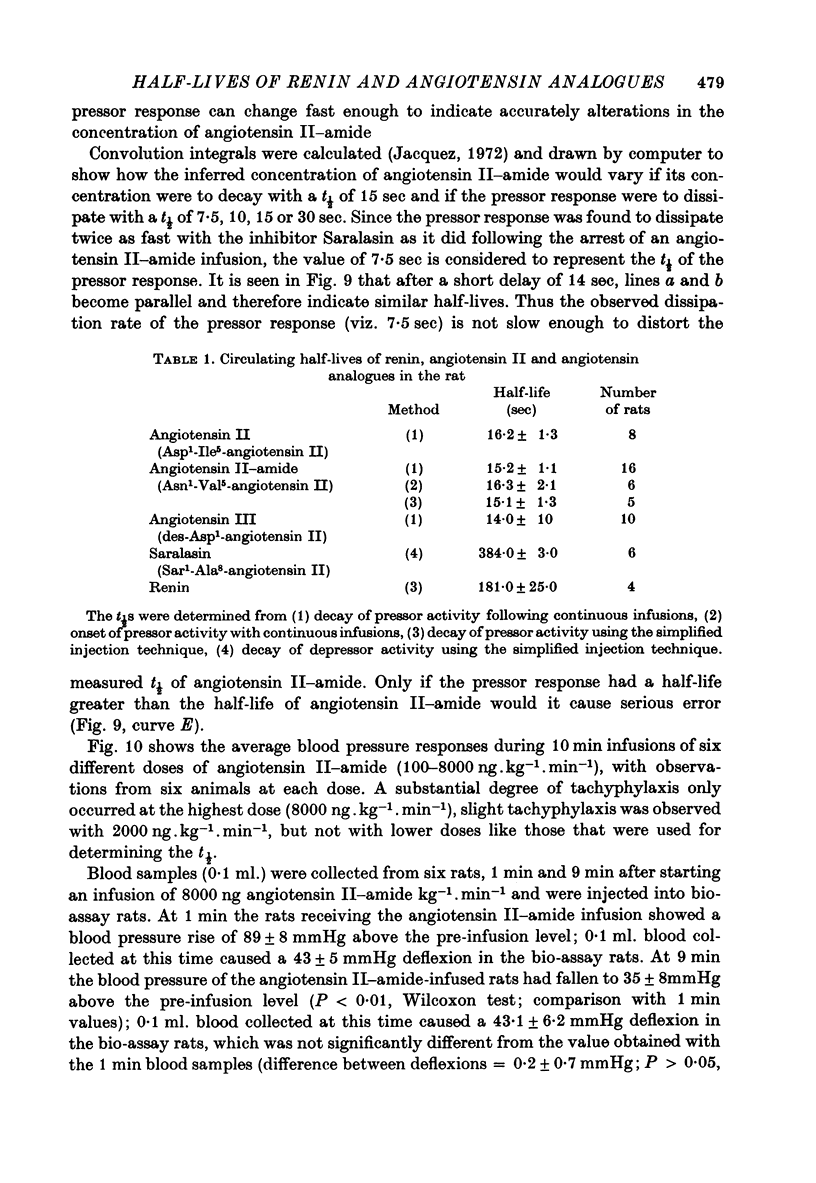


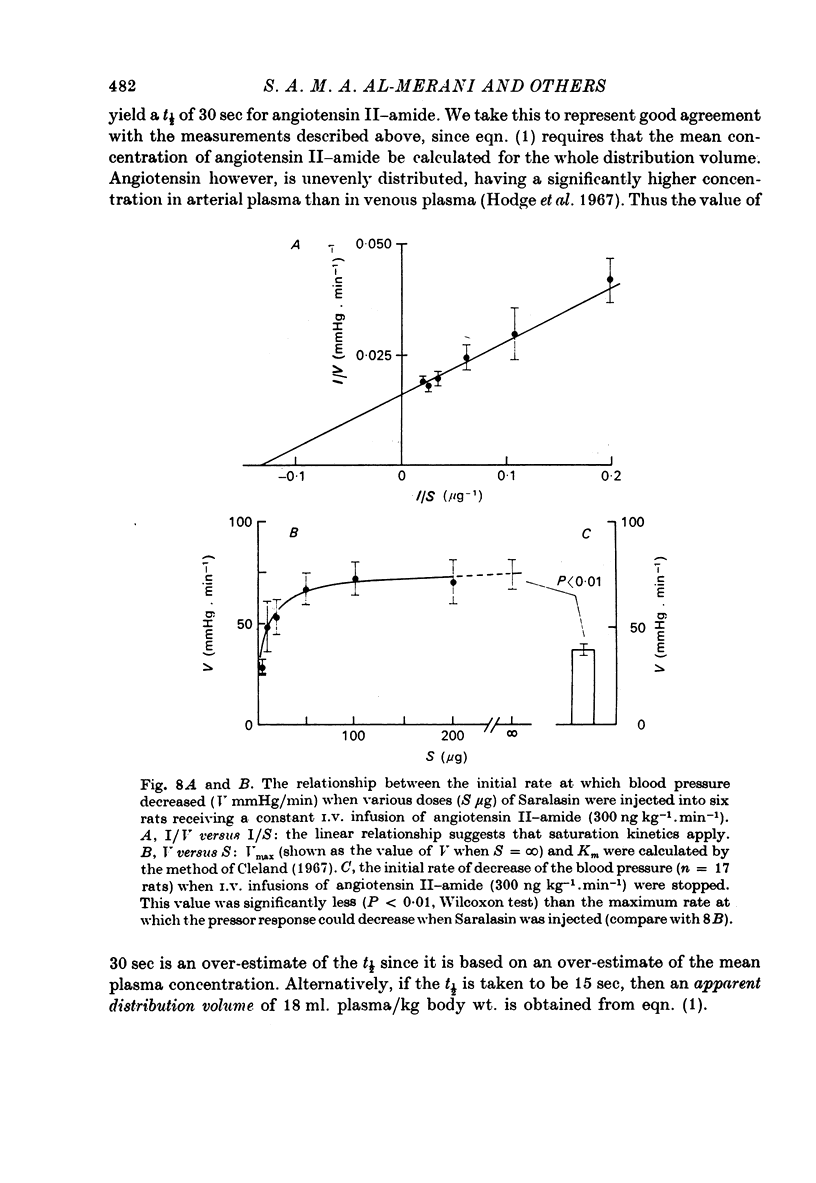

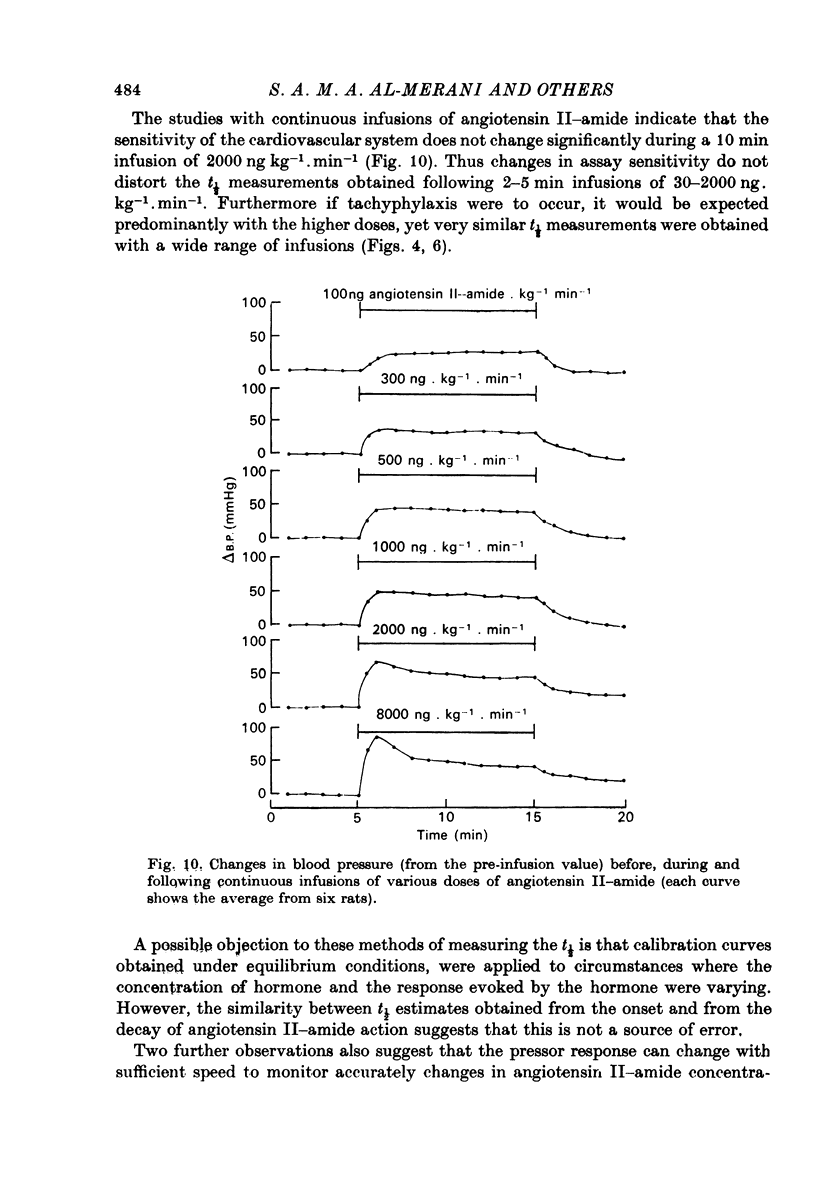

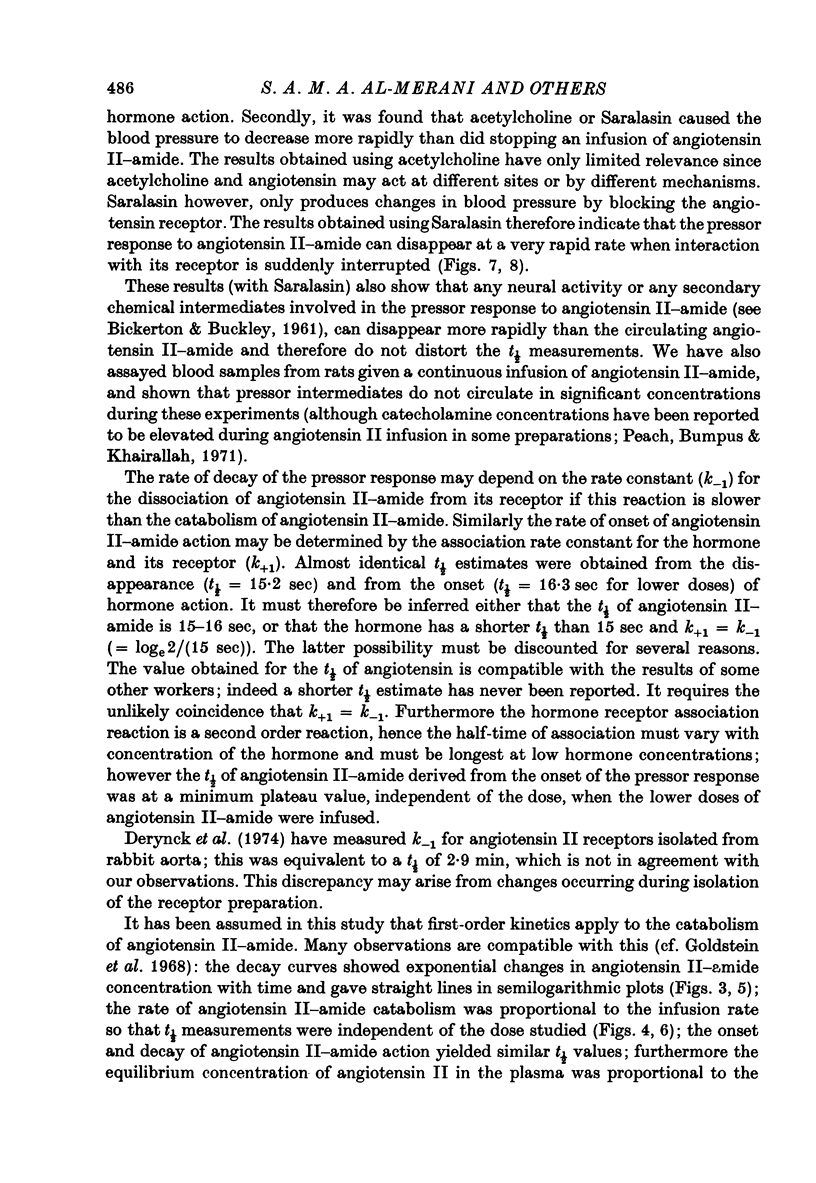
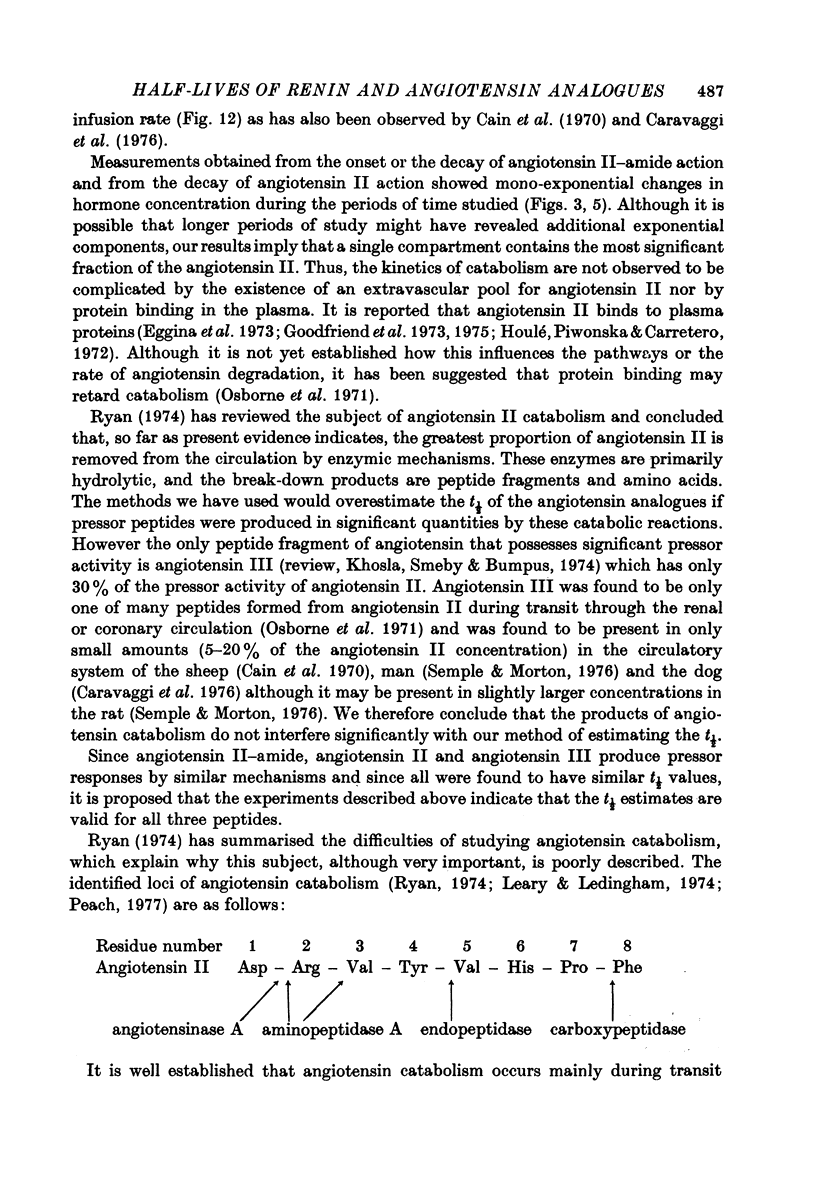


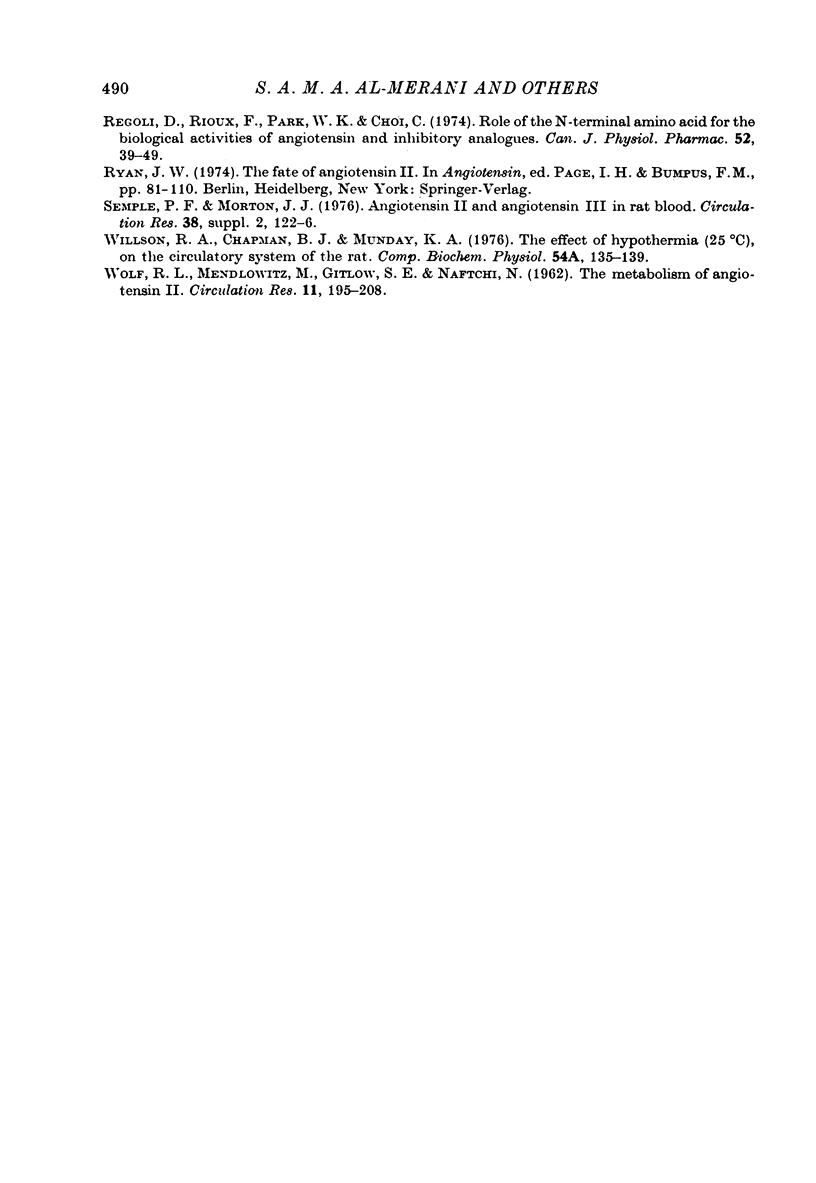
Selected References
These references are in PubMed. This may not be the complete list of references from this article.
- Assaykeen T. A., Otsuka K., Ganong W. F. Rate of disappearance of exogenous dog renin from the plasma of nephrectomized dogs. Proc Soc Exp Biol Med. 1968 Jan;127(1):306–310. doi: 10.3181/00379727-127-32678. [DOI] [PubMed] [Google Scholar]
- BOCK K. D., GROSS F. Renin and angiotensin tachyphylaxis. Circ Res. 1961 Sep;9:1044–1050. doi: 10.1161/01.res.9.5.1044. [DOI] [PubMed] [Google Scholar]
- Boyd G. W., Landon J., Peart W. S. The radioimmunoassay of angiotensin II. Proc R Soc Lond B Biol Sci. 1969 Jul 1;173(1032):327–338. doi: 10.1098/rspb.1969.0058. [DOI] [PubMed] [Google Scholar]
- Brooks D. P., Chapman B. J., Munday K. A. The half-life of angiotensin II analogues in the rat, determined from the decay of the pressor response [proceedings]. J Physiol. 1977 Feb;265(1):35P–36P. [PubMed] [Google Scholar]
- Cain M. D., Catt K. J., Coghlan J. P., Blair-West J. R. Evaluation of angiotension II metabolism in sheep by radioimmunoassay. Endocrinology. 1970 May;86(5):955–964. doi: 10.1210/endo-86-5-955. [DOI] [PubMed] [Google Scholar]
- Caravaggi A. M., Bianchi G., Brown J. J., Lever A. F., Morton J. J., Powell-Jackson J. D., Robertson J. I., Semple P. F. Blood pressure and plasma angiotensin II concentration after renal artery constriction and angiotensin infusion in the dog. (5-Isoleucine)angiotensin II and its breakdown fragments in dog blood. Circ Res. 1976 Apr;38(4):315–321. doi: 10.1161/01.res.38.4.315. [DOI] [PubMed] [Google Scholar]
- Cleland W. W. The statistical analysis of enzyme kinetic data. Adv Enzymol Relat Areas Mol Biol. 1967;29:1–32. doi: 10.1002/9780470122747.ch1. [DOI] [PubMed] [Google Scholar]
- Devynck M. A., Pernollet M. G., Meyer P., Fermandjian S., Fromageot P., Bumpus F. M. Solubilisation of angiotensin II receptors in rabbit aortae membranes. Nature. 1974 May 3;249(452):67–69. doi: 10.1038/249067a0. [DOI] [PubMed] [Google Scholar]
- Eggena P., Barrett J. D., Wiedeman C. E., Sambhi M. P. Isolation of angiotensin II binding proteins from normal human plasma by affinity chromatography. J Clin Endocrinol Metab. 1973 Oct;37(4):588–594. doi: 10.1210/jcem-37-4-588. [DOI] [PubMed] [Google Scholar]
- Haas E., Goldblatt H., Lewis L., Gipson E. C. Studies on renin. I. Purification of dog renin and micromethod for the determination of renin in dog serum and tissues. Circ Res. 1972 Jul;31(1):65–73. doi: 10.1161/01.res.31.1.65. [DOI] [PubMed] [Google Scholar]
- Hodge R. L., Ng K. K., Vane J. R. Disappearance of angiotensin from the circulation of the dog. Nature. 1967 Jul 8;215(5097):138–141. doi: 10.1038/215138a0. [DOI] [PubMed] [Google Scholar]
- Houle J. A., Piwonska A., Carretero O. A. The interaction of angiotensin with a binding factor in plasma. Experientia. 1972 Mar 15;28(3):279–280. doi: 10.1007/BF01928687. [DOI] [PubMed] [Google Scholar]
- Michelakis A. M., Mizukoshi H. Distribution and disappearance rate of renin in man and dog. J Clin Endocrinol Metab. 1971 Jul;33(1):27–34. doi: 10.1210/jcem-33-1-27. [DOI] [PubMed] [Google Scholar]
- Osborne M. J., Pooters N., Angles d'Auriac G., Epstein A. N., Worcel M., Meyer P. Metabolism of tritiated angiotensin II in anaesthetized rats. Pflugers Arch. 1971;326(2):101–114. doi: 10.1007/BF00586903. [DOI] [PubMed] [Google Scholar]
- PEART W. S. A new method of large-scale preparation of hypertensin, with a note on its assay. Biochem J. 1955 Feb;59(2):300–302. doi: 10.1042/bj0590300. [DOI] [PMC free article] [PubMed] [Google Scholar]
- Peach M. J., Bumpus F. M., Khairallah P. A. Release of adrenal catecholamines by angiotensin I. J Pharmacol Exp Ther. 1971 Feb;176(2):366–376. [PubMed] [Google Scholar]
- Peach M. J. Renin-angiotensin system: biochemistry and mechanisms of action. Physiol Rev. 1977 Apr;57(2):313–370. doi: 10.1152/physrev.1977.57.2.313. [DOI] [PubMed] [Google Scholar]
- Peters-Haefeli L. Rate of inactivation of endogenous or exogenous renin in normal and in renin-depleted rats. Am J Physiol. 1971 Nov;221(5):1339–1345. doi: 10.1152/ajplegacy.1971.221.5.1339. [DOI] [PubMed] [Google Scholar]
- Regoli D., Rioux F., Park W. K., Choi C. Role of the N-terminal amino acid for the biological activities of angiotensin and inhibitory analogues. Can J Physiol Pharmacol. 1974 Feb;52(1):39–49. doi: 10.1139/y74-006. [DOI] [PubMed] [Google Scholar]
- Semple P. F., Morton J. J. Angiotensin II and angiotensin III in rat blood. Circ Res. 1976 Jun;38(6 Suppl 2):122–126. doi: 10.1161/01.res.38.6.122. [DOI] [PubMed] [Google Scholar]
- WOLF R. L., MENDLOWITZ M., GITLOW S. E., NAFTCHI N. The metabolism of angiotension II. Circ Res. 1962 Jul;11:195–208. doi: 10.1161/01.res.11.1.195. [DOI] [PubMed] [Google Scholar]
- Willson R. A., Chapman B. J., Munday K. A. The effect of hypothermia (25 degrees C) on the circulatory system of the rat. Comp Biochem Physiol A Comp Physiol. 1976;54(1):135–139. doi: 10.1016/s0300-9629(76)80084-9. [DOI] [PubMed] [Google Scholar]


